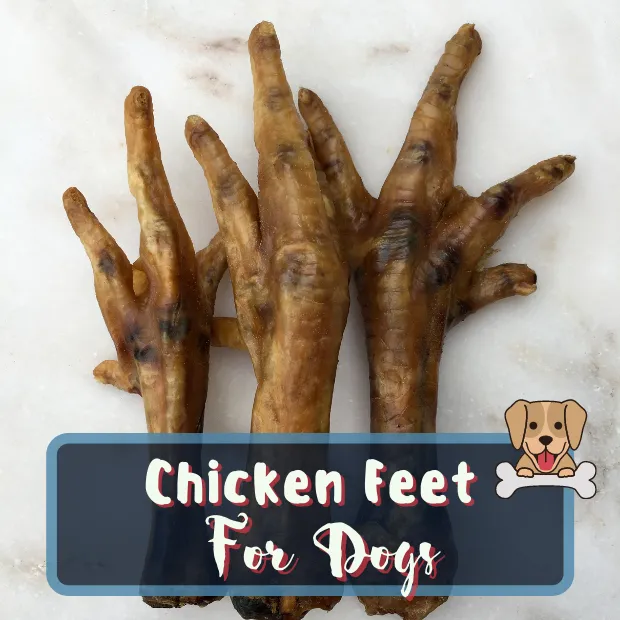Table of Contents
ToggleContents of this article:
- Are chicken feet good for my dog?
- What are the pros and cons of feeding your dog chicken feet and are they completely safe?
- What are chicken feet?
- Different types of chicken feet for dogs.
- How do I cook chicken feet for my dog?
- Are chicken feet healthy?
- Chicken feet benefits.
- Can I give chicken feet to my dog everyday?
- How many chicken feet can I give my dog?
- How long will a chicken foot last my dog?
- Are chicken feet low fat?
- Are chicken feet safe for dogs?
- Alternatives to chicken feet.
- Summary – Chicken feet for dogs.
Are chicken feet good for my dog?
Chicken feet are a popular dog treat because they are a healthy and natural choice.
Believe it or not, despite their unappealing appearance, chicken feet are also a delicacy in many parts of the world for humans!
Some people are weirded out by such lifelike treats, but they are popular because dogs love the taste of these beneficial chews.
What are the pros and cons of feeding your dog chicken feet and are they completely safe?
Chicken feet, despite their unappetizing appearance, provide several health advantages for your dog that warrant a deeper look.
In this article we will explore all your questions about chicken feet for dogs, so keep reading to find out more about this treat your dog will love!
What are chicken feet?
It doesn’t take much imagination to figure out where chicken feet come from! Turning chicken feet into dog chews is an excellent method to avoid any part of the animal from being wasted, since chickens’ feet are routinely thrown away. This makes them a very eco-friendly option.
Different types of chicken feet for dogs.
Can I feed my dog raw chicken feet?
You can buy raw chicken feet fresh or frozen from the butcher or from pet food retailers. They have not been processed in any way. After cleaning them, you can give these to your dog as they are, or dehydrate them at home so that you can store them easier.
Dehydrated chicken feet.
After they are cleaned, dehydrated and packaged, these have a long shelf life of about six months. They usually look yellow and somewhat shriveled.
Puffed chicken feet.
Puffed chicken feet are similar to dehydrated chicken feet. They are air dried to retain more vitamins and nutrients.
Compared to dehydrated chicken feet, they are whiter in color and appear puffy rather than shriveled.
How do I cook chicken feet for my dog?
You shouldn’t “cook” chicken feet but you can dehydrate raw chicken feet at home. Spread them out in a single layer in the dehydrator and dry them at 170 – 200 degrees for 24 hours.
Are chicken feet healthy?
Chicken feet are highly nutritious for dogs.
Chicken feet benefits.
- Safe to chew because they are edible and digestible.
- Encourage the development of healthy chewing habits that help keep teeth clean.
- All-natural with no chemicals, no preservatives, no additives, no color added.
- They are not made with wheat, corn, or soy.
- They are a single ingredient chew.
- The chicken feet include collagen, glucosamine, and chondroitin which are all beneficial to joint health.
Main benefits of chicken feet for dogs.
Dental Health.
Chicken feet are a great way to help clean your dog’s teeth. The chicken feet might make your dog’s breath smell weird for a little while after eating, but the chewing action helps to clean the teeth. This is because crunching on the chicken feet scrapes away food and plaque deposits on the teeth.
Although it is very important to brush your dog’s teeth regularly, if you have difficulty doing so or often forget, you can give your dog a chicken foot as a treat instead. This will help you feel less guilty about not brushing your dog’s teeth.
Joint Health.
Chicken feet are high in collagen, glucosamine and chondroitin, which are present in canine joint supplements.
These build the framework for joint cartilage, therefore helping to maintain overall joint health in arthritic dogs or those with joint issues, like hip dysplasia.
Chicken feet are a great, natural option for joint health. If you’re looking for an alternative to joint supplements, chicken feet might be a good choice.
Each chicken foot contains around 450mg of glucosamine, which is the same as the average joint supplement dose for a medium-sized dog!
Chicken feet are also a good source of calcium, which helps keep your dog’s bones strong.
Can I give chicken feet to my dog everyday?
Yes, chicken feet are a great natural daily snack for healthy dogs that are within a normal weight range.
How many chicken feet can I give my dog?
We recommend that you give your dog between one and three chicken feet per day, depending on the diet and size of your pet.
How long will a chicken foot last my dog?
A small dog might take fifteen minutes to finish it off, while a large dog will likely be done in less time.
Are chicken feet low fat?
Chicken feet are mostly skin, tendons, small bones and cartilage. They have a low calorie content compared to processed commercial snacks. They are high in protein and moderate in fat.
Remember, even healthful chews contribute to your dog’s calorie count. As a result, if you give them as a reward, reduce your dog’s daily ration of food slightly.
Are chicken feet safe for dogs?
As long as your chicken feet haven’t been cooked, they are quite safe. However, you may want to cut the nails off if they are not already trimmed. These snacks should not cause any issues in a healthy and fit dog.
Chicken feet may seem frightening to some dog owners, as they have probably heard the warning “NEVER offer a dog cooked chicken bones.” Cooked poultry bones are susceptible to fracturing and creating intestinal perforations and blockages in dogs, which can be fatal.
Chicken feet, on the other hand, are not cooked. They’re either uncooked, dehydrated, or puffed. As a result, as your dog chews through the treat, the bones break rather than splinter or shatter because they are crunchy and crumbly.
The nails are the only portion of the chicken feet that might cause difficulties. They may be sharp and more difficult to digest than other parts of the foot.
Dog treat producers sometimes trim the nails during preparation, but if they aren’t trimmed, you can do it yourself. They’re easy to remove with a pair of kitchen scissors. If they are very short, many dog owners don’t worry about them.
When your dog is eating a new treat for the first time, it’s crucial to monitor them to ensure there aren’t any problems.
Are chicken feet suitable for all dogs?
Dogs who are prone to pancreatitis may experience an unpleasant flare-up from eating chicken feet because of the fat percentage.
Chicken feet will not be suitable for dogs who are allergic to chicken.
However, there are alternatives available if you’re looking for something different.
Chicken feet for puppies.
Chicken feet are not suggested for puppies under the age of four months, since they need some ability to crunch through them. This will safeguard the puppy’s developing teeth and avoid them choking.
Alternatives to chicken feet.
Do you like the idea of chicken feet, but are not sure if they are for you? There are other options that might work better for you and your dog.
- Duck feet are a great alternative to chicken feet if your dog is allergic to chicken. They contain high levels of collagen, glucosamine and chondroitin, which are good for your dog’s joints. Duck is a protein that is often okay for dogs with food allergies. They can be harder to find and they are higher in fat, which means overweight dogs or dogs with pancreatitis should avoid it.
- Chicken necks are a wonderful source of nutrients. They have a similar composition as chicken feet, high in glucosamine and chondroitin. The main disadvantage of chicken necks is that they can be a problem for dogs who might gulp them down and get into trouble.
- Pizzle or bully stick is a great single-ingredient chew that can help improve your dog’s dental health. Made from dried bull penis, pizzle is low fat and long-lasting.
- Rabbit ears are a good, natural choice. They clean your dog’s teeth and don’t smell too bad or leave greasy stains. They are very low in fat and take longer for most dogs to consume. They’re available with fur on, which some people view as a natural dewormer but which many others find disconcerting.
- Pig ears are another good choice for a natural product that helps keep your dog’s teeth healthy. Much like chicken feet, pig ears help to clean the teeth as your dog chews on them. Pig’s ears are a high-fat food that should not be given to overweight dogs or dogs with pancreatitis. They are also high in cartilage and skin, like chicken feet. However, they are smellier and more greasy than chicken feet.
Summary – Chicken feet for dogs.
So, if you’re a pet parent, you’ll be glad to know that raw, dehydrated and puffed chicken feet are safe for dogs to eat. They offer many health benefits for your dog’s teeth and bones, making them a great addition to your dog’s diet.
For more ideas on how to keep your dog mentally stimulated with enrichment activities, check out this post on Kongs.







